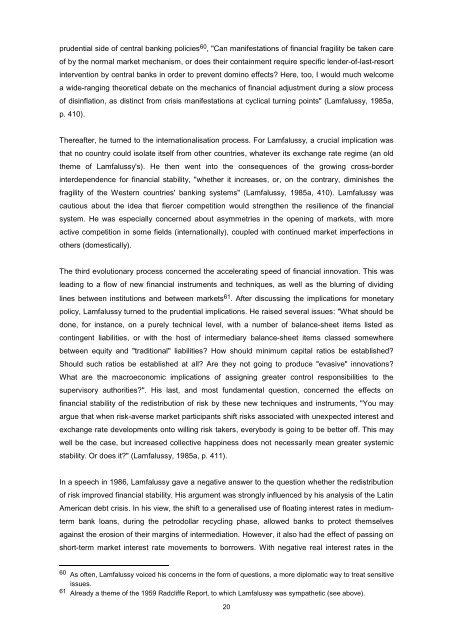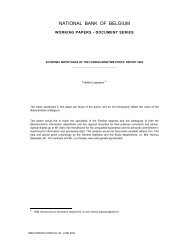Working Paper Research - Nationale Bank van België
Working Paper Research - Nationale Bank van België
Working Paper Research - Nationale Bank van België
Create successful ePaper yourself
Turn your PDF publications into a flip-book with our unique Google optimized e-Paper software.
prudential side of central banking policies 60 , "Can manifestations of financial fragility be taken careof by the normal market mechanism, or does their containment require specific lender-of-last-resortintervention by central banks in order to prevent domino effects? Here, too, I would much welcomea wide-ranging theoretical debate on the mechanics of financial adjustment during a slow processof disinflation, as distinct from crisis manifestations at cyclical turning points" (Lamfalussy, 1985a,p. 410).Thereafter, he turned to the internationalisation process. For Lamfalussy, a crucial implication wasthat no country could isolate itself from other countries, whatever its exchange rate regime (an oldtheme of Lamfalussy's). He then went into the consequences of the growing cross-borderinterdependence for financial stability, "whether it increases, or, on the contrary, diminishes thefragility of the Western countries' banking systems" (Lamfalussy, 1985a, 410). Lamfalussy wascautious about the idea that fiercer competition would strengthen the resilience of the financialsystem. He was especially concerned about asymmetries in the opening of markets, with moreactive competition in some fields (internationally), coupled with continued market imperfections inothers (domestically).The third evolutionary process concerned the accelerating speed of financial innovation. This wasleading to a flow of new financial instruments and techniques, as well as the blurring of dividinglines between institutions and between markets 61 . After discussing the implications for monetarypolicy, Lamfalussy turned to the prudential implications. He raised several issues: "What should bedone, for instance, on a purely technical level, with a number of balance-sheet items listed ascontingent liabilities, or with the host of intermediary balance-sheet items classed somewherebetween equity and "traditional" liabilities? How should minimum capital ratios be established?Should such ratios be established at all? Are they not going to produce "evasive" innovations?What are the macroeconomic implications of assigning greater control responsibilities to thesupervisory authorities?". His last, and most fundamental question, concerned the effects onfinancial stability of the redistribution of risk by these new techniques and instruments, "You mayargue that when risk-averse market participants shift risks associated with unexpected interest andexchange rate developments onto willing risk takers, everybody is going to be better off. This maywell be the case, but increased collective happiness does not necessarily mean greater systemicstability. Or does it?" (Lamfalussy, 1985a, p. 411).In a speech in 1986, Lamfalussy gave a negative answer to the question whether the redistributionof risk improved financial stability. His argument was strongly influenced by his analysis of the LatinAmerican debt crisis. In his view, the shift to a generalised use of floating interest rates in mediumtermbank loans, during the petrodollar recycling phase, allowed banks to protect themselvesagainst the erosion of their margins of intermediation. However, it also had the effect of passing onshort-term market interest rate movements to borrowers. With negative real interest rates in the60 As often, Lamfalussy voiced his concerns in the form of questions, a more diplomatic way to treat sensitiveissues.61 Already a theme of the 1959 Radcliffe Report, to which Lamfalussy was sympathetic (see above).20
















